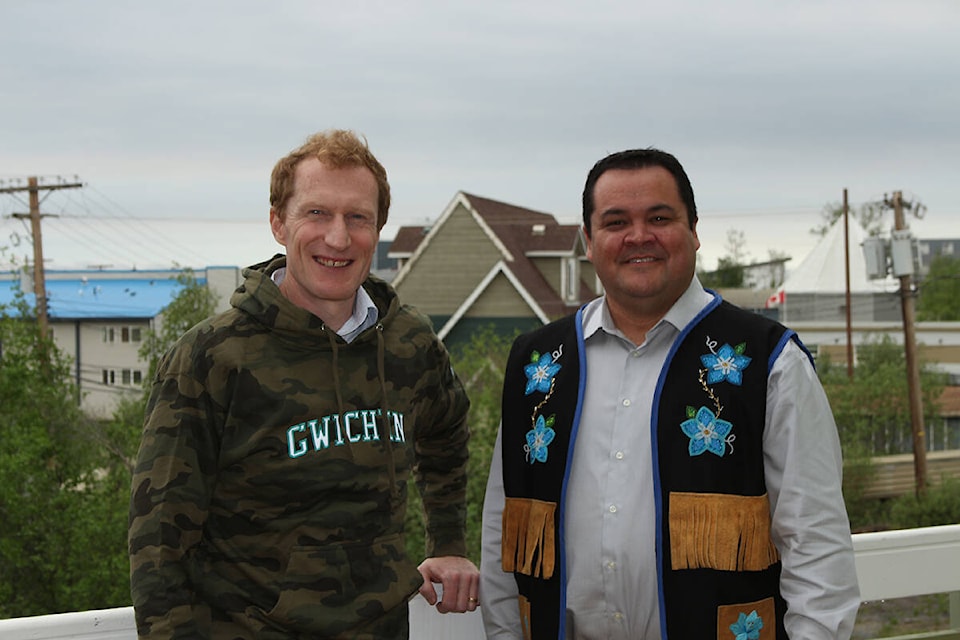A longstanding dream of the Gwich’in Tribal Council is now years ahead of schedule thanks for support from the federal government.
Crown and Indigenous Relations Minister Marc Miller was in Inuvik June 29 to announce Ottawa was contributing $2.3 million to the Gwich’in Wellness Camp project. The funding is part of a $108.8 million program to fund Indigenous cultural centres across the country and is part of a larger framework of wellness initiatives, as called for by the Truth and Reconciliation Commission.
“I hope our investment actually helps them on the path to wellness and having a healing camp that’s on the land,” he said. “It would be nice to see it in person if I get a chance.”
Miller also gave a nod to NWT MP Michael McLeod for his work on sourcing the funding.
Originally started in 2008, the Rachel Reindeer Wellness Camp was forced to shut down due to mounting operational costs in 2015. Launched with funding from an oil and gas boom, the facility fell victim to overenthusiastic infrastructure spending, including a large diesel generator.
“It could probably power Tsiigethchic,” said GTC chief operating officer Sharla Greenland, who joined Nihtat President Kelly McLeod in a presentation of the facility.
McLeod said the facility installed a 39 kilowatt solar array in March and hasn’t burned an ounce of diesel since. On top of this, the building now has a biomass furnace for heat and power.
He added the funding from the federal government would accelerate the initiative’s timeline by allowing for the construction of supportive infrastructure, including gazebos and outdoor gathering facilities.
“It’s a game-changer for us,” said Kelly McLeod. “With these funds the government has provided to us, we’re able to skip a few years and get really into things. So it is very much appreciated.
“It may seem small but it’s huge for us.”
Gwich’in Tribal Council Grand Chief Ken Kyikavichik said the facility would be operating on a limited basis before the end of the year and he hopes it will be in full operation by next year.
He noted the site isn’t a treatment centre in itself, as the logistics of running one are significant, but would serve as a detox location for people hoping to access an addictions treatment centre, as well as a place to transition back into the community following treatment.
But the facility won’t just be for addictions recovery, it will also be used as a meeting place for conferences and tourists. Kyikavichik said the GTC intended to have snowmobiles and yurts on hand for people to go out on the land but are not able to do so themselves. He mused a restaurant could even be opened at the facility during the winter months.
Pledge for support for school searches
Miller added the federal government is now reaching out to communities to arrange for financial support in searching for the remains of victims of the residential school system. But the decision to engage in a search would be up to individual communities, he added.
“We’ve been scrambling at the outset to get money out to committees that really were in a position to do those searches on their terms,” he said. “We want to make sure that people do have the option to do those searches.
“(The) Canadian government, along with the churches and religious institutions that operated these services, are responsible for a lot of devastation that went on. It isn’t up to us to decide what conditions to impose upon searches.”
He noted the bigger part of such endeavours is the community outreach to survivors, to determine where the remains of lost children may rest. Some communities may also want to exhume the buried children and provide a proper funeral for them.
Kyikavichik said most of the schools in the Inuvik area were opened in the 1950s, but the region’s history with the residential school system goes back much earlier.
“Between 1920 and 1940 a lot of our young people in my grandparents generation went to schools in Hay River and Fort Providence, primarily Hay River,” he said. “In the 1920s and ‘30s, the Distributor, which was an old steamship, used to come down the Mackenzie and bring groceries.
“Then it would take the kids back upriver to the residential schools. In my grandparents’ generation, many of our great grandparents’ generation, they would put their young children on it — some as young as four or five, six years old — and then not see them for five or six years. Some of them would put three children on the boat, and one or two would come back and all they would be told is their child didn’t make it after the first year and they had to learn to accept that.
“Those stories are common in our communities. So when we started undertaking this ground-truthing in places like Hay River, we’re going to find a lot of these people.”
